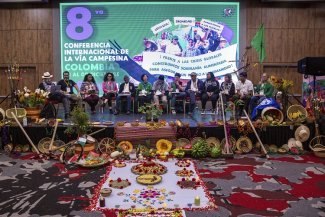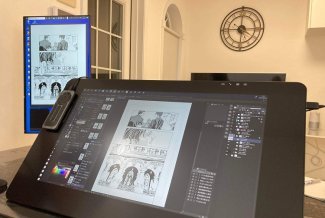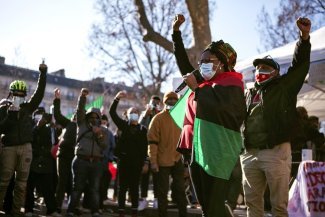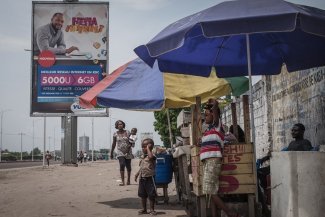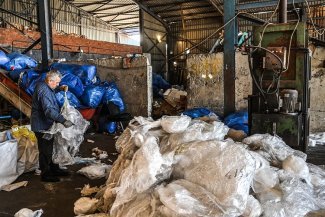
The names and ages of the victims of the Acteal massacre are written on painted crosses in the victims’ memorial tomb in the Tzeltal village of Acteal in Chiapas, Mexico. On 22 December 1997, a group of paramilitaries killed 45 Indigenous people, including four pregnant women, in this small village in the Chiapas highlands.
[Editor’s note, 6 July 2021: It is with great sadness that we have learned that Simón Pedro Pérez López, a Tzeltal community leader who was interviewed in the article below, was assassinated by paramilitaries on 5 July 2021. According to an update on the website of the Fray Bartolomé de Las Casas (Frayba) Center for Human Rights in Chiapas, Pérez was shot while shopping in a local market with his son. In the article below, Pérez forewarned Equal Times: “We are not talking about history when we mention the 1997 massacre; we are talking about now.” We send our deepest condolences and solidarity to Pérez’s family, and to the Indigenous communities of Acteal, Chiapas, Mexico, Latin America and the world over who are fighting for their lives, their land and the basic recognition of their right to live in peace.]
The murder of Indigenous people by paramilitary groups in Mexico is so routine that it is not even considered news. According to the 2020 World Report by Human Rights Watch, the Mexican government does not provide reliable data on extrajudicial murders and violent attacks on Indigenous activists. However, in documents seen by Equal Times, local organisations report that 499 attacks against Indigenous land defenders and environmental activists took place in Mexico between 2012 and 2018.
While the world’s attention has been focused on the devastation caused by the coronavirus pandemic (Mexico currently has the world’s third highest Covid death toll after the United States and Brazil), and in the absence of international and national human rights observers, over the last year, paramilitaries have increased their attacks on Indigenous rights activists, land defenders and community organisers.
On 15 February, 100 days after he went missing, the dead body of Indigenous activist Miguel Vázquez Martínez was found in an unmarked grave in the state of Veracruz. On 23 January, Fidel Heras Cruz was murdered in the state of Oaxaca. Between 18 and 21 January, paramilitary groups attacked the autonomous community of Moisés Gandhi with firearms and shot at the community’s residential houses for several hours. The comprehensive list of attacks is, however, much longer than this.
“There is a long history of paramilitarism in many countries in Latin America,” says Michael A. Paarlberg, a political science professor at Virginia Commonwealth University in the United States. In Mexico, a new form of paramilitarism emerged, in response to the Zapatista uprising in 1994. While several Indigenous Maya communities took up arms under the name of the Zapatista Army of National Liberation (EZLN) to protect their ancestral land and fight inequality and discrimination in southern Mexico, right-wing armed groups with the covert support of the federal government and influential regional figures launched attacks on Indigenous people. A decade later, as drug cartels increased their presence in Mexico, an alliance was formed between narco-traffickers and paramilitaries to control territories owned by Indigenous people and to force them to leave their ancestral land.
Paarlberg says that this increase follows a regional pattern: “We have seen it with the Autodefensas in Colombia, the Rondas in Peru, and the Patrullas in Guatemala. We see a rise in paramilitary activity in areas with little state presence, weak institutions, lack of proper security or reliable justice.”
In Mexico, while a March 2020 nationwide quarantine restricted the activities of human rights organisations and Indigenous rights defenders, paramilitaries quickly seized the opportunity to expand their territorial control. This occurred more significantly in Chiapas and Oaxaca southern states, where the largest Indigenous populations live.
“There is no pandemic for the paramilitaries,” says Rubén Moreno, an Indigenous rights activist from the southern city of San Cristóbal de las Casas, in Chiapas, Mexico’s poorest state. “Paramilitaries continue their violent actions, and Indigenous people have no access to justice. This is absolute discrimination – and why does it exist? Because we are Indigenous.”
Article 2 of the Mexican Constitution, approved in 1917 during the height of the Mexican Revolution, emphasises Indigenous people’s right to autonomy, self-determination, and the right to maintain control of their ancestral land. However, what is written on paper is very different from the reality for Indigenous communities subjected to structural racism, social exclusion and everyday discrimination.
The Tzotzil, Tzeltal and Zoque Indigenous people of San Cristóbal still remember that as recently as the early 1990s, they were not allowed to walk on their city’s high and narrow sidewalks if they were occupied by white or mestizo Mexicans. Any Indigenous person had to step down from the pavement and walk on the roads, which are more akin to rivers during San Cristóbal’s infamous rainy season.
An unending history of mass killings
Today, discrimination is still pervasive. Despite the fact that according to the 2015 census, Indigenous Mexicans account for 10.1 per cent of the population, almost 70 per cent of Indigenous Mexicans live in poverty, with minimal access to health care and education. Once destroyed by Spanish invaders, small villages of native Mexican communities are still under attack and subjected to mass killings. The latest such incident took place in June 2020, when paramilitaries took advantage of the quarantine and murdered 15 Ikoots residents of Huazantlán del Río village in Oaxaca.
Pedro Faro, director of the Fray Bartolomé de las Casas Human Rights Centre in Chiapas, says that the number of attacks on Tzeltal communities in Aldama, a mountainous region in Chiapas, has also risen sharply since the beginning of the pandemic. According to the data recorded by this centre, 658 armed attacks took place in different Aldama villages between 17 April 2018 and 17 September 2020. Between 18 September and 30 November of 2020, the Indigenous people of Aldam were under attack 410 times.
“With the pandemic, conflicts have been intensified in regions which had already suffered from violence,” explains Faro. “Aldama is just one example. Paramilitary groups have been reactivated, and the violence of armed groups has increased in different regions of Chiapas like Chalchihuitán, Chilón, Carmen San José and Moisés Gandhi.”
Meanwhile, rights activists have warned that paramilitary violence cannot be fully comprehended without acknowledging the federal government’s role in the country’s ongoing violence against Indigenous people. Faro even goes further by saying that human rights organisations purposely use the term ‘paramilitary’ for right-wing armed groups to indicate their relationship with the official army.
“We talk about paramilitary groups because they are totally dedicated to military activities,” underlines Faro. “We also see that there is complicity between the state and these groups. That’s why the state does not touch them.”
According to analysts and activists, the government deploys paramilitary groups when it does not want to intervene directly, like the 2006 mass murder of Indigenous people in Viejo Velasco and the 1997 massacre of Acteal. In both of these incidents, the country’s official armed forces were stationed close to the location of the massacres, where they could even hear the sound of the shootings, but did nothing to stop the violence.
“The value paramilitaries offer to governments is a willingness to carry out actions official security forces cannot,” Paarlberg explains. “[Actions] such as illegal trafficking, the persecution of political rivals, or extrajudicial killings of civilians, while giving government officials plausible deniability about those human rights abuses. And their [the paramilitary groups’] power is in the fear they generate through the unpredictable and brutal nature of their violence.”
Indigenous people under fire
In a February 2020 statement, the civil society group Las Abejas de Acteal, criticised the government’s role in the arming of paramilitary groups:“When will the bad government stop responding with arms, armies, barracks, checkpoints and by training paramilitary groups to the demands of people who only want to live in peace?”
Las Abejas (The Bees) is one of the most active civil society organisations in the Chiapas highlands, advocating peaceful mobilisation to build autonomy in Indigenous communities and raise awareness about paramilitary groups in Mexico. Formed in 1992 in response to the violation of native people’s rights, the organisation succeeded in unifying Tzeltal farmers and villagers in the Chiapas municipality of Chenalhó. However, they paid a heavy price for their achievements when in 1997, over 100 paramilitaries entered the village of Acteal and brutally murdered 45 women, men, and children during a prayer meeting.
“We are not talking about history when we mention the 1997 massacre; we are talking about now,” says Simón Pedro Pérez López, a Tzeltal community leader and former head of Las Abejas, referring to the current presence of paramilitaries in the region. “Now, in Chiapas, we are living in the same situation [as in 1997]. We have not seen any change, and the previous governments have followed the same idea and politics [of the government in 1997].”
In September 2020, the federal government offered an “amicable agreement” in the form of a public apology to the families of the Acteal massacre, reparations and acceptance that the government had not taken all necessary measures to prevent the murders. However, Las Abejas rejected the offer because it wants the government to hold an investigation into the murders, assume full responsibility for the killings and hold the perpetrators accountable.
In a small chapel in Acteal, standing near an altar still bearing the bullet holes from the 1997 massacre, Pérez López calmly explains that the government’s relations with the paramilitaries have remained intact despite changes to the people in power.
Like many other Indigenous community leaders, he knows that his life is in danger, a reality that demonstrates the federal government’s failure in fulfilling its promises to bring justice to Indigenous communities.
“The government says that it wants to bring equality and peace here to Chiapas, but for us, it’s just a lie,” Pérez López adds. “The paramilitaries are using their arms in Aldama and Santa Marta, and they [the government] know who the armed ones are, but yet they don’t want to punish them. So, where is the equality they talk about? Where is peace? Where is justice?”




